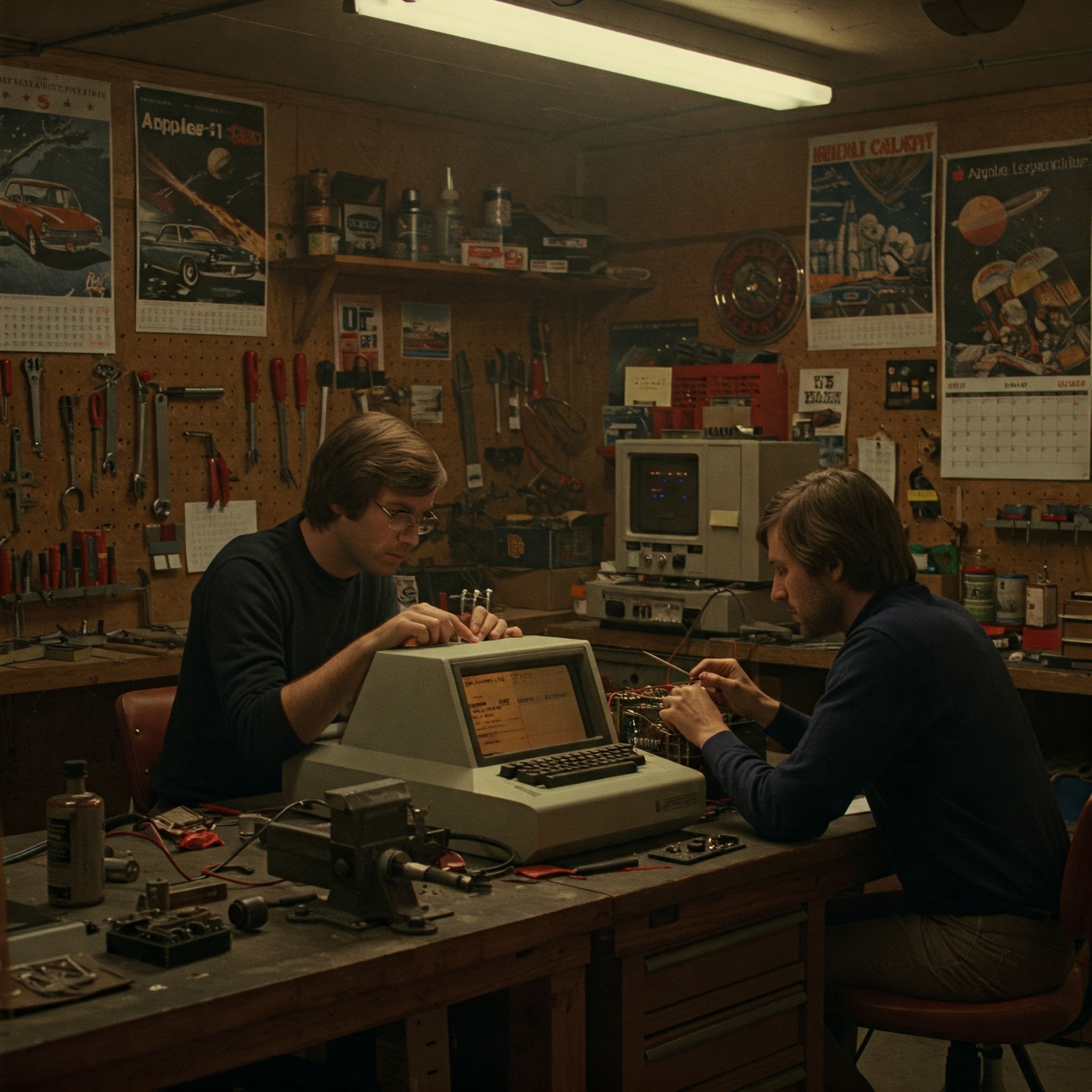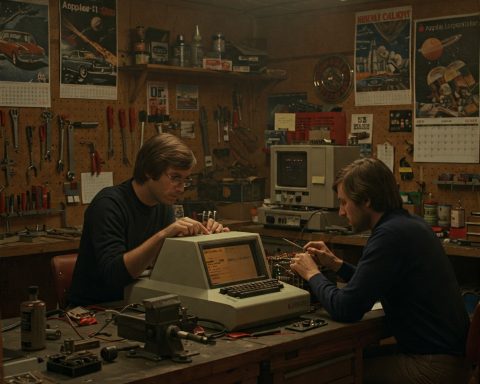In the annals of personal computer history, few machines hold the mystique and value of the Apple I. Born not in a state-of-the-art lab, but in a suburban garage , this humble machine, initially sold for $666.66 , was the genesis of Apple Computer Company, the enterprise that would eventually reshape technology. Today, a working Apple I is a collectible Apple computer fetching hundreds of thousands, sometimes close to a million dollars at auction , a testament to its pivotal role as the seed from which a global technology giant grew.
From Hobbyist Dream to Silicon Valley Legend: The Creation
The story of the Apple I begins with Steve Wozniak, a brilliant young engineer working at Hewlett-Packard in the mid-1970s. An avid electronics hobbyist and member of the burgeoning Homebrew Computer Club in Silicon Valley , Wozniak dreamed of owning a personal computer. Inspired by the community and early machines like the Altair 8800 showcased at the club , he set out to design his own, primarily for personal use like accessing the early ARPANET and playing games, and crucially, to impress his peers at the club.
The Homebrew Computer Club was more than just a meeting place; it was a vital incubator for the personal computer revolution. It fostered an open exchange of ideas, schematics, and code. Wozniak, deeply embedded in this collaborative culture, initially designed the Apple I with the intention of sharing the plans freely. He demonstrated his prototype at the club in July 1976, showcasing an elegant design that minimized chips for affordability and uniquely included video output capabilities.
It was Wozniak’s friend, Steve Jobs, who saw the commercial potential. While Wozniak possessed the engineering genius, Jobs had the vision and marketing drive to turn the invention into a product. Jobs persuaded a hesitant Wozniak that they should start their own company to sell the machine, even if only as a bare circuit board. To fund their nascent venture, Apple Computer Company, founded on April 1, 1976 , they famously sold prized possessions: Jobs’s VW minibus and Wozniak’s HP programmable calculator, raising about $1300. The first Apple I computers were hand-built in the garage of Jobs’s parents’ house.
The Deal That Launched Apple: The Byte Shop Order
The transition from a garage operation to a fledgling company hinged on a single, crucial deal. After Wozniak demonstrated the Apple I prototype at the Homebrew Computer Club, it caught the attention of Paul Terrell, who was opening one of the world’s first computer retail stores, the Byte Shop, in Mountain View, California. Jobs approached Terrell, initially proposing to sell the Apple I as a kit for hobbyists to assemble themselves.
Terrell, however, recognized a shift in the market towards more accessible machines. He rejected the kit idea, insisting he would only buy the computer if it came fully assembled. This demand was strategically pivotal. It forced Apple away from the purely hobbyist model and towards creating a more complete, user-friendly product – a philosophy that would define the company’s future. Terrell placed a landmark order for 50 assembled Apple I units at a wholesale price of $500 each, payable cash-on-delivery.
This $25,000 order was transformative. It provided Apple with desperately needed credibility and leverage to obtain parts on 30-day credit from suppliers like Cramer Electronics. Jobs, Wozniak, and their small team worked frantically to assemble and test the boards, delivering them on time. The Byte Shop deal provided essential capital and pushed Apple into manufacturing. Wozniak himself later called Terrell’s order “the biggest single episode in all of the company’s history”. The retail price was set at $666.66, reflecting Wozniak’s fondness for repeating digits and a standard one-third markup.
Under the Hood: Apple I Specifications
Wozniak’s design for the Apple I prioritized affordability and basic usability. Its technical specifications reflect these goals:
- Processor: The heart of the Apple I was the inexpensive yet capable MOS Technology 6502 microprocessor, running at approximately 1 MHz. The 6502 cost significantly less than competing chips like the Motorola 6800, making it ideal for a budget-conscious design.
- RAM: The standard configuration came with 4 kilobytes (KB) of Dynamic RAM (DRAM), expandable to 8 KB directly on the main board. Wozniak’s use of cheaper DRAM instead of the more common Static RAM (SRAM) was another cost-saving measure. Memory could be further expanded up to 64 KB via the expansion slot.
- Input/Output (I/O): A key innovation was the inclusion of integrated video terminal circuitry, providing composite video output. This allowed users to connect the Apple I to a standard television set or a composite monitor, a significant advantage over machines requiring dedicated, expensive terminals. The display showed 24 lines of 40 characters. Input required users to supply their own ASCII keyboard. An optional cassette interface ($75) allowed programs, including Wozniak’s own Integer BASIC, to be loaded from and saved to standard audio cassette tapes.
- What You Got (and Didn’t): Unlike kits, the Apple I was sold as a fully assembled and tested main circuit board. However, it was far from a complete system. Users still needed to provide their own casing, power supply (with specific voltage requirements), keyboard, and video display. This highlights the Apple I’s position as a crucial bridge between complex hobbyist kits and the fully integrated personal computers like its successor, the Apple II.
| Feature | Specification |
|---|---|
| CPU | MOS Technology 6502 @ approx. 1 MHz |
| RAM (Standard) | 4 KB |
| RAM (Onboard Max) | 8 KB |
| RAM (External Max) | 64 KB (via expansion slot) |
| Video Output | Composite Video (40×24 characters) |
| Keyboard Input | Requires external ASCII keyboard |
| Storage (ROM) | 256 Bytes (System Monitor) |
| Storage (Optional) | Cassette Tape Interface ($75) |
| Included | Assembled & Tested Main Circuit Board |
| Required | Case, Power Supply, Keyboard, Monitor/TV |
| Original Price | $666.66 (with 4 KB RAM) |
A Computer for Enthusiasts: Production and Market
The Apple I was never intended for the mass market. Its production run was extremely limited, with only about 200 units ever manufactured. Most of these, around 175, were sold within the nine or ten months the machine was officially on the market. The target audience consisted primarily of electronics hobbyists, computer enthusiasts, and members of the Homebrew Computer Club – individuals with the technical skills and willingness to source the additional components needed to make the machine fully operational. This limited production, dictated by the company’s initial lack of capital and the niche market focus, is a primary reason for the Apple I’s extreme rarity and high value today.
The Dawn of Personal Computing: Significance and Legacy
While its direct market impact was modest due to low production numbers, the Apple I holds immense significance in personal computer history. It was one of the first pre-assembled personal computers available, lowering the barrier to entry compared to the complex kits common at the time. Its integrated video output was a crucial feature making computers more accessible. Most importantly, the Apple I served as Apple Computer Company’s foundational product. Its existence proved the viability of Wozniak’s designs and Jobs’s vision, establishing the company and paving the way financially and conceptually for its successor, the Apple II. The Apple II, a fully integrated machine with color graphics launched in 1977, would truly revolutionize the industry.
The transition was swift. Apple offered a trade-in program, encouraging Apple I owners to return their original machines for a discount on the new Apple II. This move not only spurred adoption of the superior Apple II but also served a practical purpose: freeing Wozniak, the sole designer, from the burden of supporting the older hardware. This trade-in program, reflecting the rapid pace of innovation and the challenges of early hardware support, further contributed to the rarity of surviving Apple I units. The Apple I’s primary legacy, therefore, lies in its role as a catalyst – it launched Apple and directly enabled the creation of the machine that would put the company on the map.
An Icon of Tech History: The Apple I Today
Today, the Apple I exists as a legendary artifact of the digital revolution. Of the original ~200 units, estimates suggest fewer than 80 survive, with only a small fraction still operational. Tracked by resources like the Apple-1 Registry , these machines are highly coveted by museums and private collectors worldwide.
As a collectible Apple computer, the Apple I commands extraordinary prices at auction. Sales consistently reach hundreds of thousands of dollars, driven by rarity, historical significance, and the cultural narrative surrounding Apple’s origins. Notable auction results include $375,000 in 2024 , $458,711 in 2020 , and a record-breaking $905,000 paid by the Henry Ford Museum at a Bonhams auction in 2014. The value is heavily influenced by the machine’s condition, operational status, completeness, and provenance – especially any documented connection to Steve Wozniak or Steve Jobs. Owning an Apple I is akin to owning a piece of history, a tangible link to the moment the personal computer era began to blossom.
Conclusion: From Garage Kit to Million-Dollar Relic
The journey of the Apple I encapsulates the quintessential Silicon Valley story: innovation sparked by hobbyist passion, propelled into reality by entrepreneurial spirit, and catalyzed by a crucial early deal. Although quickly superseded by the Apple II, the Apple I’s importance cannot be overstated. It was the machine that launched Apple Computer, proved the concept of a relatively affordable and usable personal computer, and set the stage for a technological revolution. From its humble beginnings in a garage to its current status as a multi-hundred-thousand-dollar vintage computer, the Apple I remains an enduring symbol of ingenuity and the genesis of one of the world’s most influential companies.






